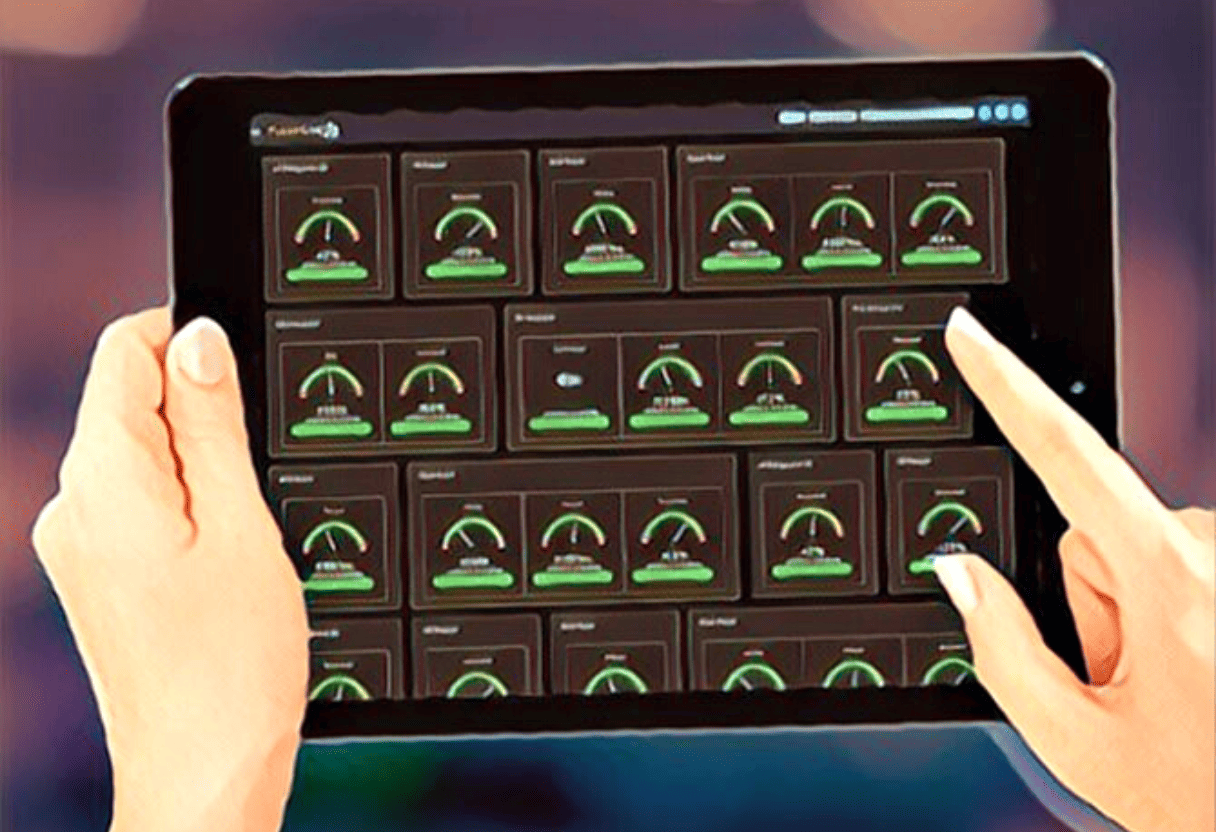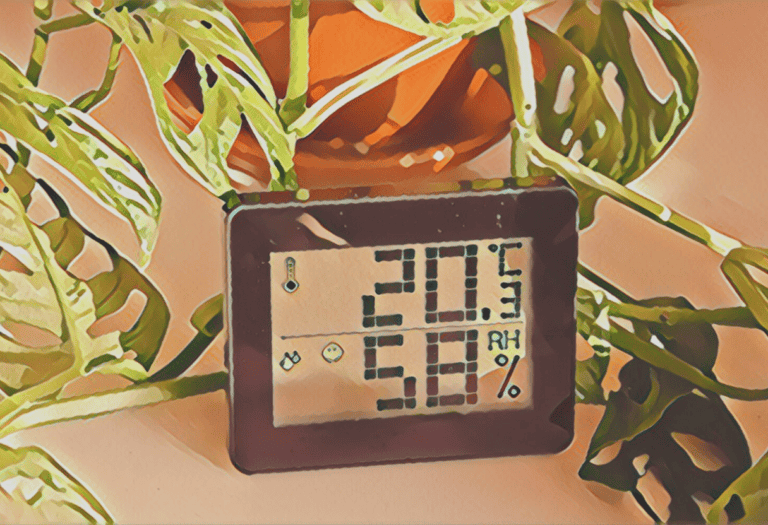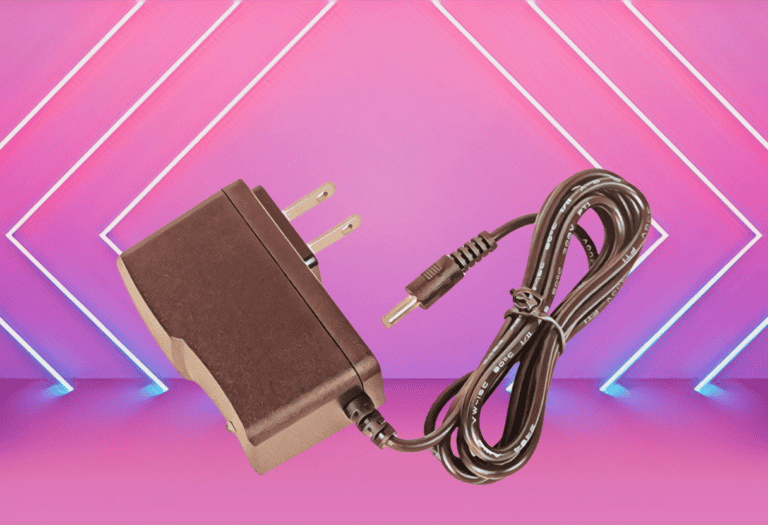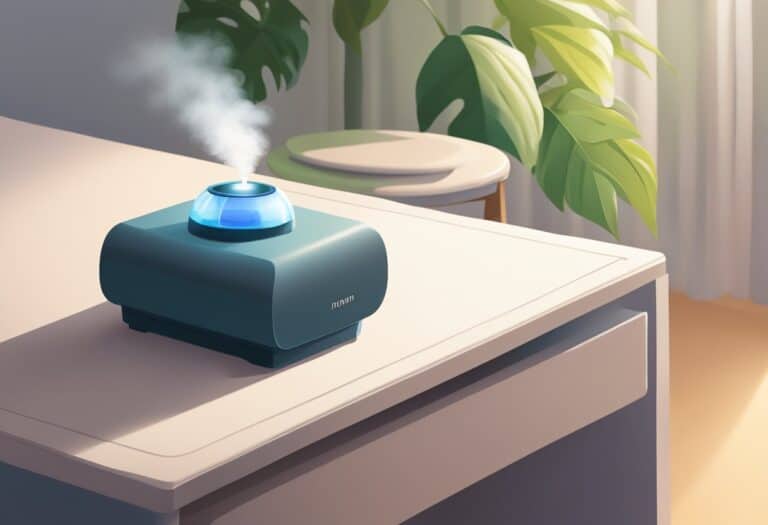Looking for a way to effortlessly monitor and control your environment’s climate?
Remote temperature monitors in 2024 have become increasingly sophisticated, offering precise and efficient climate control solutions. These devices are essential for homes, businesses, and locations where maintaining the correct temperature is critical.
By allowing remote monitoring of temperature and sometimes humidity levels, they bring convenience and reassurance, as users can be alerted to any significant changes without being physically present.
Well, we’ll be going over:
- What are the key features to look for in a remote temperature monitor to suit your specific needs?
- How do these monitors vary in terms of range, accuracy, data logging capabilities, and alert systems?
- Which models are currently leading the market in 2024 for their reliability and user-friendly features?
Finding the right remote temperature monitor can significantly enhance your ability to maintain an ideal climate, whether for comfort or critical storage needs.
Let’s dive in.
Top Remote Temperature Monitors
- Govee H5179 – Top Pick
- ThermoPro TP357 Hygrometer
- U UNNI Weather Guide
- GoveeLife Bluetooth Thermometer
- Govee Indoor Hygrometer
I’ve researched extensively and tested numerous devices to bring you the most reliable remote temperature monitors available on the market. These gadgets are essential for homeowners looking to maintain optimal conditions in their environment, whether for general comfort or to protect sensitive items from temperature fluctuations. The following products stand out for their accuracy, ease of use, and connectivity features.
Govee H5179
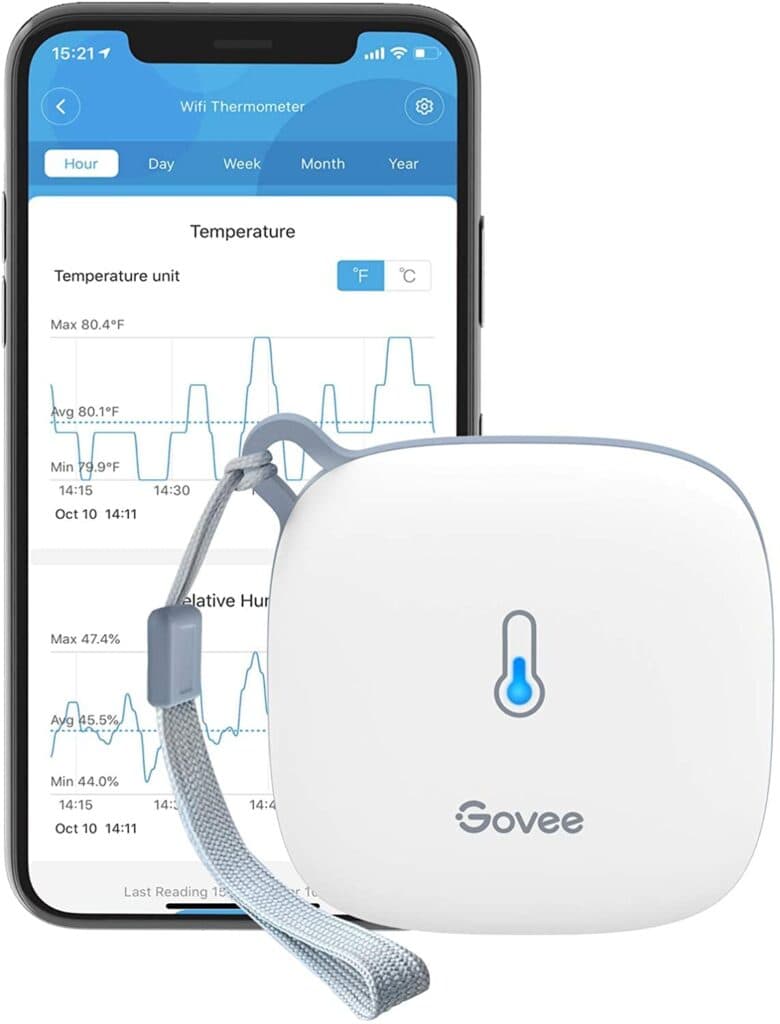
After my hands-on experience with the Govee H5179, I’m convinced it’s a reliable choice for anyone needing to monitor temperature and humidity remotely.
Pros
Cons
Recently, I integrated the Govee WiFi Thermometer Hygrometer into my greenhouse setup. The first thing I noticed was the ease of installation; just a few taps in the app and it was good to go. The device’s accurate readings ensure I’m always aware of the slightest changes in the environment.
The free data storage in the Govee Home app is a gem for long-term trend monitoring. It’s been helpful for me to see how the conditions fluctuate over time, allowing me to adjust my plants’ care accordingly.
However, the device’s limitation to 2.4GHz Wi-Fi networks is worth mentioning. Although my home network was compatible, it could be a hiccup for those on 5G. There were a couple of instances where the Wi-Fi connectivity wavered, but they were quickly resolved.
I would have appreciated the option to share access to the app’s data with my family. Currently, it’s tied to a single user, an aspect to consider if multiple people are involved in monitoring.
In essence, the Govee H5179 strikes a good balance between functionality and user-friendliness. While there’s room for improvement in network compatibility and app sharing, it stands out as a strong candidate for remote temperature and humidity monitoring.
ThermoPro TP357 Hygrometer
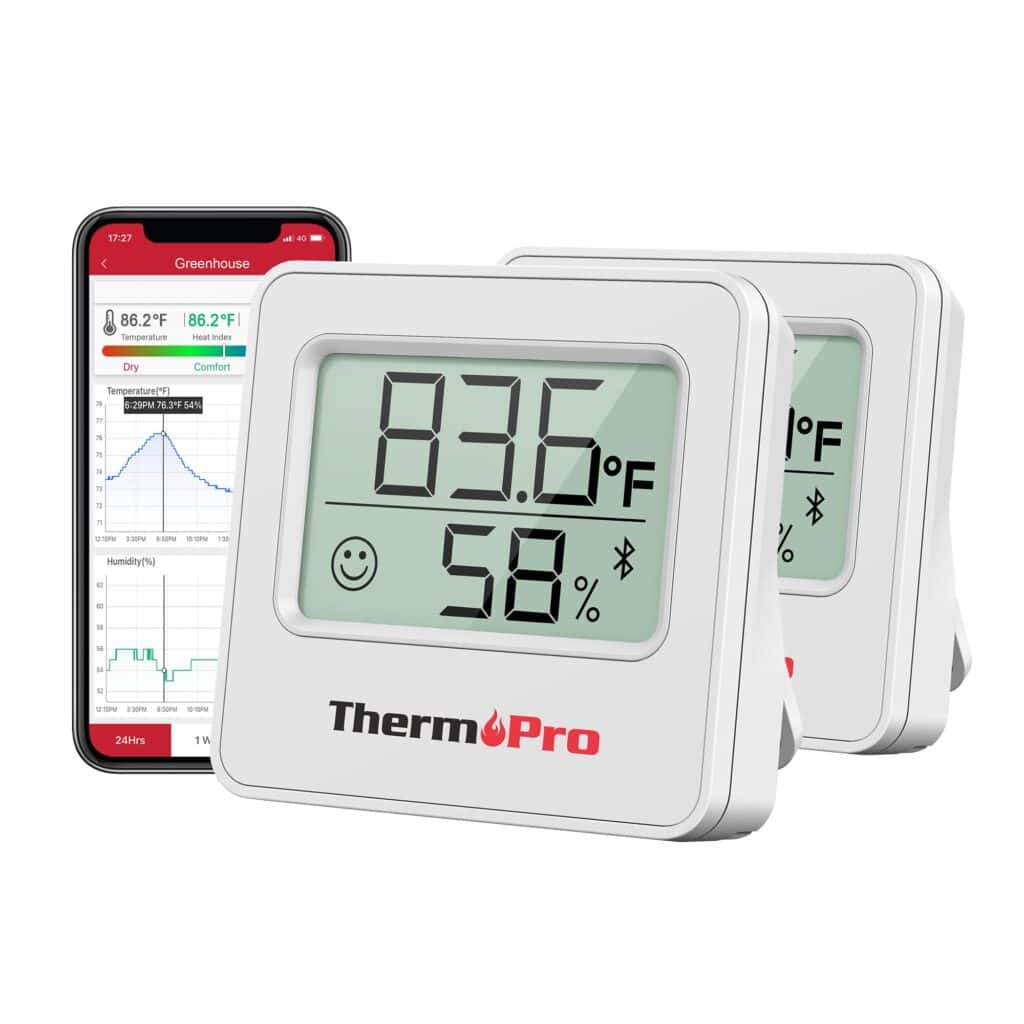
I found the ThermoPro TP357 to be a reliable tool—its real-time data helps maintain an appropriate living environment.
Pros
Cons
Setting up this hygrometer, I noticed the comfort face indicators right away, they really simplified reading the current air quality. After placing it in my living room and pairing it with my phone, the Bluetooth range proved as robust as advertised—even my basement was in range.
The smart notifications caught my attention; when I set specific thresholds, my phone buzzed the moment conditions strayed, allowing me to act quickly. This feature added an extra layer of convenience, letting me go about my day without constant check-ins.
Handling the device was a breeze, and its compact size made it unobtrusive. Using it alongside my humidifier, I could genuinely tell it was reading the room’s air accurately compared to my other devices. It’s been a subtle yet essential addition to my home.
U UNNI Weather Guide
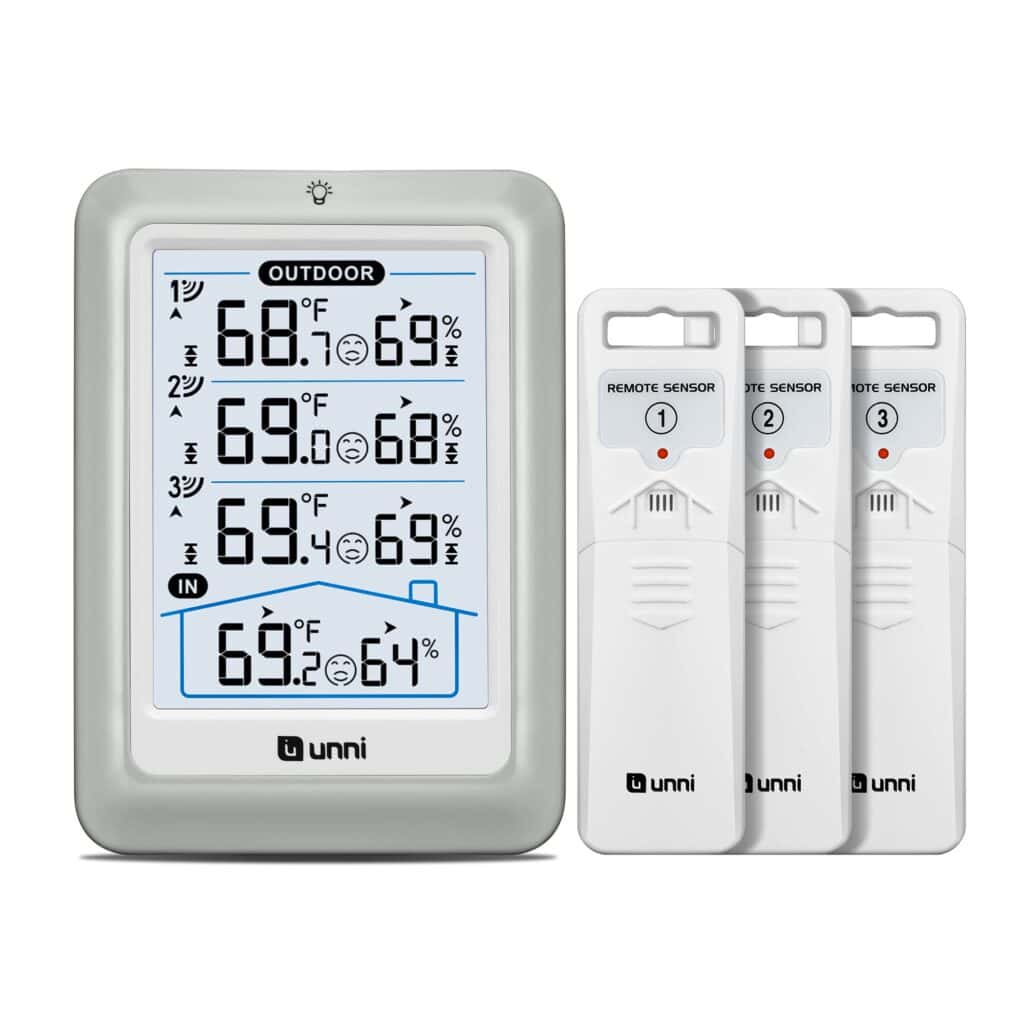
I believe this weather station is a valuable addition for anyone interested in precise and consistent climate monitoring for both indoor and outdoor environments.
Pros
Cons
After getting a hands-on experience with the U UNNI Weather Guide, I found it quite impressive. Its straightforward setup was a relief – no need to fiddle with complex instructions. The device started relaying temperature and humidity data almost instantly, and the 330-foot range came in handy. I had sensors teed up in different spots – the garden, garage, and living room – and the clarity of the information allowed me to make real-time adjustments.
The adjustable brightness on the 4.5-inch display is a thoughtful touch, ensuring visibility day and night. Whether mounted on the wall or propped on my desk, a quick glance gave me all the data I needed. The convenience of USB power is a plus, though keeping batteries on hand provides peace of mind in case of a power outage.
My favorite feature? The accuracy. Whether I was monitoring my greenhouse or keeping an eye on the nursery, I felt confident in the readouts. Even when placing the three sensors in close proximity, the minor differences reflected their micro-environments accurately – a sign of the system’s precise calibration. However, the bulkier design of the sensors was a bit out of place in sleeker settings, like my wine cooler, but their performance outweighed any aesthetic concerns.
Being directly acquainted with the U UNNI Weather Guide, I can vouch for its utility. The occasional inconvenience of adjusting the backlight or swapping out batteries does little to mar an otherwise reliable performance. This gadget deftly caters to my keen interest in environmental conditions, delivering real-time data with pinpoint precision. It’s earned its place on my desk – and perhaps it will earn a place in your home too.
GoveeLife Bluetooth Thermometer
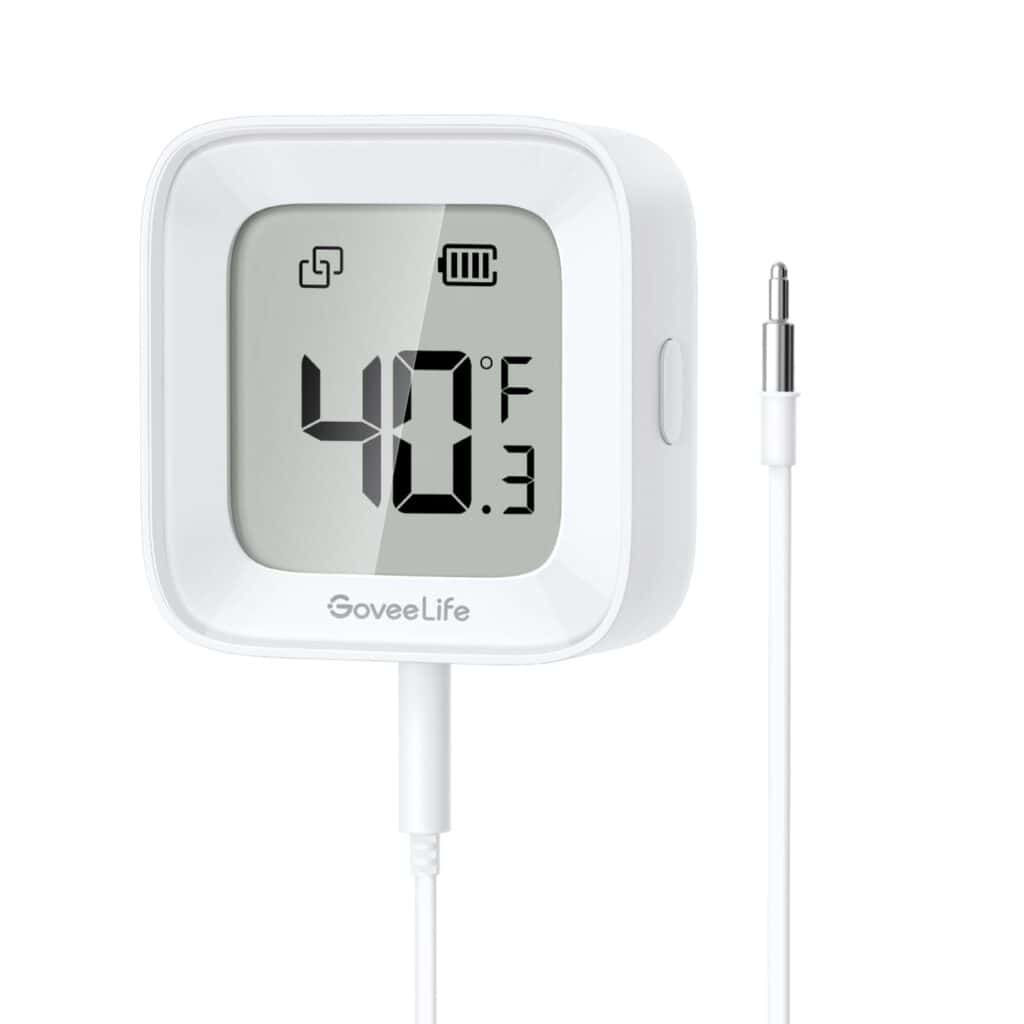
I find this GoveeLife thermometer to be a smart choice for those wanting to keep a close, remote eye on their freezer temperatures.
Pros
Cons
I recently incorporated the GoveeLife Freezer Thermometer into my home setup and its ease of use genuinely impressed me. Connecting it to my phone took minimal effort, and I was monitoring temperatures in no time. The refresh speed of the sensor kept the readings constantly up to date, which is vital for sensitive items like stored food or medication.
I appreciated the thoughtful design of the GoveeLife thermometer, especially the magnetic back and included lanyard. This allowed me to place it strategically in my freezer without worrying about it shifting around. Plus, the tidy cable management was a nice touch, avoiding the usual clutter.
One of the smart features that stood out to me was the smart anti-false alarm function. Nobody likes being bombarded with notifications, and this thermometer smartly waits a moment before deciding to send an alert after a quick temp spike such as opening your freezer door.
However, it’s worth mentioning that to unlock the full potential of this device, purchasing the additional WiFi Gateway is almost a must—it significantly extends the range beyond the standard Bluetooth limitation. And while the system adeptly pushes notifications to my phone, there’s no substitute for an onboard audible alert, something you might miss if you’re not near your device.
In conclusion, my experience with the GoveeLife freezer thermometer has been largely positive. It’s a robust tool for anyone who needs to keep a vigilant eye on temperature-sensitive environments. With its precise monitoring and smart features, it makes remote temperature monitoring nearly effortless.
Govee Indoor Hygrometer
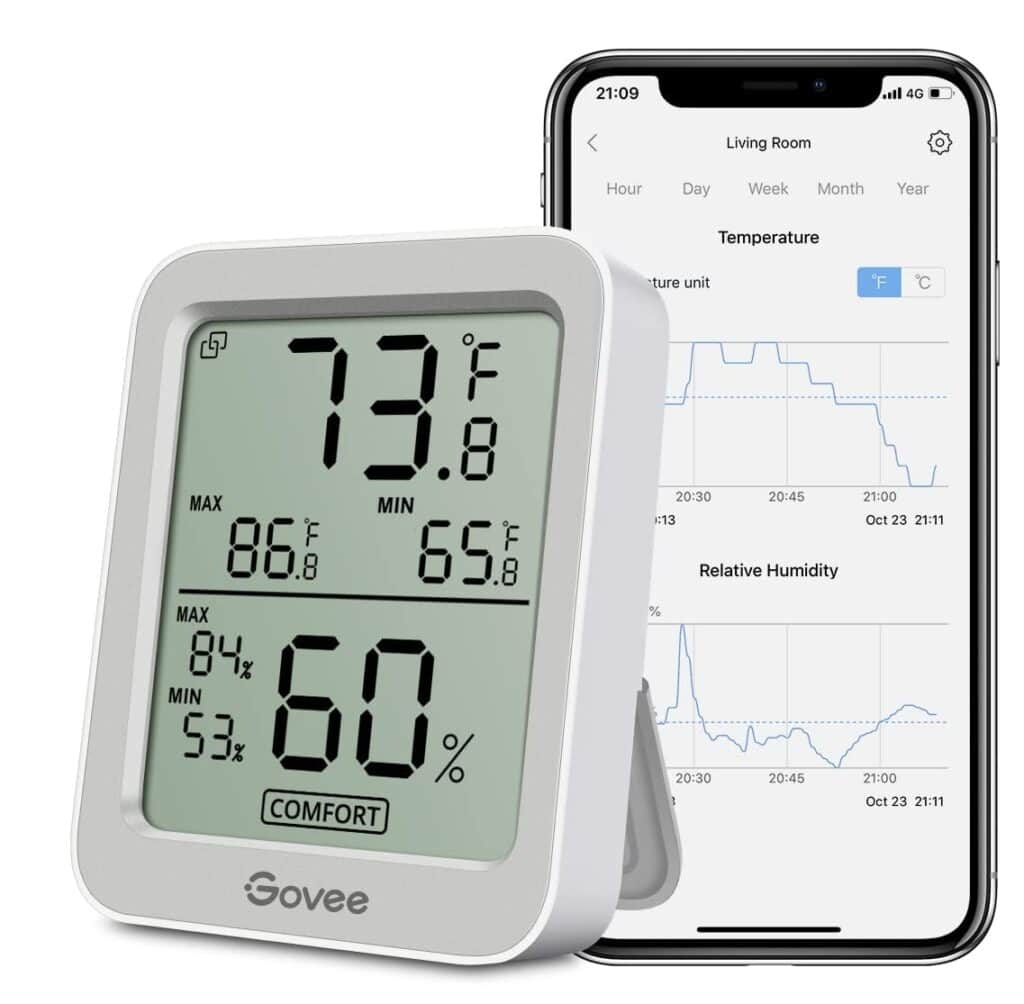
I’d recommend the Govee Indoor Hygrometer for anyone needing to keep tabs on their indoor climate with accuracy and ease.
Pros
Cons
Having this Govee hygrometer in my home has given me peace of mind with my climate-sensitive collections. The setup was a breeze, and I had it paired with the app on my phone in minutes. The large LCD display, which shows temperature and humidity readings, is clear and easily visible, even from across the room. The device updates every couple of seconds, providing me with real-time, accurate measurements.
The app notifications are a standout feature for me. Whenever my room’s conditions fall outside the thresholds I set, I get alerts straight to my phone. This has been indispensable for preventing my precious plants from sitting in an unfavorable environment for too long. I’ve even used the historical data graphs to adjust my heating and cooling schedule which has helped me maintain a more consistent environment.
Of course, it’s essential to be aware of the hygrometer’s Bluetooth range limitations. To check the readings or receive alerts, I need to be within a 196ft/60m range. So, if I’m out of range, I’ll miss out on real-time updates until I return. This isn’t usually a problem for me as I mostly use it at home, but it’s something to keep in mind for those who need remote monitoring from further distances.
The extensive storage for data is excellent for detailed analysis over time, but not everyone may need this feature. While I’ve enjoyed looking back at past environmental conditions, especially when planning room changes or looking to optimize certain conditions, casual users might find they don’t utilize the 20 days of online data storage and export functions to the fullest.
Buying Guide
When purchasing a remote temperature monitor, it is vital to consider several key features to ensure that the product meets my specific requirements. Here are the factors that I look into:
Connectivity
I check the type of connectivity supported by the monitor, such as Wi-Fi, Bluetooth, or cellular. A reliable connection is crucial for real-time updates and notifications.
Range
I assess the range of the sensor, as it must be capable of transmitting data over the distance between the location being monitored and where I’ll receive the data.
Accuracy
The accuracy of temperature readings is non-negotiable. I look for a monitor with a low margin of error to ensure precise measurements.
Battery Life
With battery-operated monitors, I consider the battery life, as I prefer a device that requires infrequent charging or battery changes.
Alerts and Notifications
It is important for me to be notified immediately if temperatures fall outside of the preset ranges. I look for devices that offer alerts via app notifications, emails, or text messages.
Data Logging
I verify whether the temperature monitor can log data over time, which is beneficial for tracking trends and keeping records for analysis.
Ease of Use
The device interface should be intuitive. I prefer monitors that offer a user-friendly app for remote access to the readings and settings.
Here is a quick reference table summarizing the main features to compare:
| Feature | Why It Matters |
|---|---|
| Connectivity | Ensures I can receive data reliably |
| Range | Monitor should cover required space |
| Accuracy | Precision in temperature readings |
| Battery Life | Convenience of maintenance |
| Alerts & Notifications | Essential for immediate action |
| Data Logging | Useful for historical data analysis |
| Ease of Use | Simplifies interaction with the device |
By taking these features into account, I can choose the best remote temperature monitor that suits my specific needs.
Frequently Asked Questions
In this section, I’ll provide succinct answers to some common queries about remote temperature monitoring, addressing smartphone integration, reliability, non-Wi-Fi solutions, user opinions, and the benefits of different sensor types.
What options are available for monitoring home temperature via smartphone?
Smartphone integration for home temperature monitoring is facilitated by a range of apps connected to Wi-Fi-enabled thermostats and sensors like Nest, Ecobee, and Honeywell. These systems usually require a central hub that connects to your home’s Wi-Fi network and communicates with an associated mobile app.
What are the most reliable Wi-Fi-enabled temperature monitoring systems for residential use?
For reliability, systems like the Ecobee SmartThermostat and the Nest Learning Thermostat top the list. They offer consistent Wi-Fi connectivity, intuitive interfaces, and are backed by strong customer support and continuous software updates.
How can I accurately monitor indoor temperature without Wi-Fi connectivity?
Accurate indoor temperature monitoring without Wi-Fi is possible with radio frequency (RF) systems and standalone data loggers like SensorPush or La Crosse, which store temperature data for later retrieval and analysis without the need for real-time internet connectivity.
What are the top-reviewed remote temperature monitoring devices according to users on forums like Reddit?
On forums like Reddit, devices such as the Ambient Weather WS-2902C and SensorPush Wireless Thermometer/Hygrometer frequently receive high praise for their accuracy, durability, and user-friendly interfaces.
What are the advantages of wireless versus plug-in remote temperature sensors?
Wireless temperature sensors offer the advantage of flexible placement and portability, making them ideal for monitoring areas where plug sockets are not readily available or for temporary setups. In contrast, plug-in sensors often provide a more stable power source and can be more cost-effective as they do not require batteries.
Which temperature and humidity monitoring sensors offer the best precision and connectivity?
For the best precision and connectivity in monitoring both temperature and humidity, devices like the SensorPush Wireless Thermometer/Hygrometer and the Temp Stick Wifi Temperature & Humidity Sensor are often recommended. They are known for their accurate sensing technology and user-friendly apps that can provide instant data to connected devices.

